Sensory processing

Sensory processing is the way that we order and categorise sensory information to help manage our everyday life and make sense of our world.
We all have differences in the way our sensory processing works, but for some children their sensory development is delayed or disordered which can cause them to be distressed, anxious or angry.
There are many ways to support a child with sensory processing differences. On this page you will find useful films, training, resources and links to help. We ask that parents /carers and professional access these and implement the strategies both in the Films and training tab and in the Strategies tab prior to making a referral. Schools will be required to upload evidence of completing the Sensory circuits programme. If you are thinking a referral may be needed please contact Therapy One Point 0300 123 2650 to discuss the child before taking this step.
Films and training
Conducting sensory circuits
Sensory circuits
Parent sensory workshop
The aim of the workshop is to help you to better understand your child’s sensory processing preferences and challenges so that you can support them at home, at school and in the community.
The workshop has been designed to watch in three parts and can be re-visited at any time to refresh your knowledge. Please ensure that you watch all three to ensure maximum benefit. The aim is to give you the confidence to help coach and enable your child to come up with their own sensory strategies.
Introduction to sensory processing
The senses
Strategies
The idea of strategies is to enable your child to engage in their daily activities and routines by doing something differently. As Laura says in the video, 'you know your child best’ and by trying out one strategy at a time you will be able to monitor how these have, or have not helped. It takes time for strategies to take effect and be embedded into the daily routine.
You may wish to make notes during the workshop videos as this will help you to start thinking about strategies that are unique to your child. Not all strategies will work and it is a process of trial and error. If your child is verbal and able to actively get involved in coming up with strategies that will help build their problem-solving skills and sense of control. Strategies may just need some tweaking to be effective but will need to be consistently used for 12 weeks to measure impact.
Please use the Sensory strategies family record sheet to record your child's progress.
Many families find that the workshop enables them to develop a suite of strategies. Remember that we are all unique and it is not possible to change a person's sensory processing. The aim is to enable your child to engage in every day age-appropriate activities. Your child may still benefit from reasonable adjustments in the classroom (such as regular movement breaks) or while out in the community (noise-reduction headphones).
If after three months of using different strategies, your child is still having difficulties participating in everyday activities because of the sensory processing challenges, you can contact our Occupational Therapy One Point Team on 0300 123 2650. During the call you will be asked to provide evidence of what has been trialled already so we can better help advise on next steps.
Videos and sensory workshop content shared with thanks from Kent Children’s Therapies – The Pod pages.
How to create a bespoke sensory circuit and how to set targets
Step 1: Identify the child or young person’s (CYP’s) sensory preferences
Every person is unique, each developing likes or dislikes. For example, we get dressed, eat and carry out tasks in a particular way. We have preferences for personal space, often influenced by our environmental, psychological and emotional factors.
What strategies is the CYP using? For example, making sounds/humming in order to sit and complete tasks in the classroom.
What sensory motor experience is the child seeking? For example, chewing pen top or sleeve, constantly moving position while sat.
Is it working for the CYP? – in other words does the strategy improve their engagement or ability to function in the classroom?
If not, does the strategy need to be changed? For example, it isn’t improving function or is inappropriate behaviour or placing others at risk.
Remember: However disruptive a sensory behaviour maybe you must never take away a sensory-motor strategy without replacing it with one that works better or is more appropriate for the CYP age/or minimises risk to others.
Step 2: Sensory detective work
When observing a CYP you will need to note how they react to different types of touch, movement, smells, visually, sound, temperature and pain. It is important to note whether they are stiff, floppy, coordinated as well as their behaviour which may indicate a task is challenging. This may include being uncooperative, anxious or avoidant.
- Observe the CYP in various settings in school (hall, playground and classroom)
- Observe the CYP based on the demands of a task
- Observe at different times of the day/with different CYP or supporting adults present
- Look for patterns of behaviour
Step 3: Complete sensory observation (CSO) checklist
Complete the Complete sensory observation (CSO) checklist from the sensory circuits manual (page 55).
Step 4: Praxis checklist
Complete the checklist below which will help identify difficulties related to sensory motor skills. When you have identified areas of need you can tailor a circuit to not only support self-regulation but promote motor skill acquisition. For example, difficulties using cutlery or dressing skills require use of two hands together. Activities in the organising section of a sensory circuit, such as lying prone on a scooter-board and throwing beanbags onto a target will help promote bilateral coordination (using both sides of the body together). Poor balance may indicate poor core stability so activities that utilise tummy muscles (core) or challenge balance such as using a space-hopper or hopping will help promote muscle tone.
Follow the symbols which are used throughout the manual and attached to each suggested activity to help plan a circuit to address underlying needs (refer to page 12-15). Symbols include praxis, proprioception, vestibular system, tactile input, bilateral and balance.
Sensory motor checklist
Do any of these statements apply? If yes then include activities to improve function in these areas
Vestibular:
- Avoids P.E/ team activities.
- Loses balance easily or fatigue when completing school work (slumped posture).
- Appears uncoordinated or floppy
Tactile: Good tactile processing is required in order to develop manual dexterity/ mature fine motor skills through discrimination of temperature, texture. Size and shape. For example, when doing up buttons on clothing.
- Unable to adjust force/direction when throwing a ball
- Using too much pressure when using a pen/pencil
- Difficulty manipulating small objects
Bilateral: Ability to cross the midline is a precursor to development of bilateral coordination (using both sides of the body together). CYP need to be able to cross the midline of their body to write from left to right, jump with two feet together, use cutlery, dress themselves and during most self-care activities.
- Unable to skip or complete jumping jacks
- Difficulty commando crawling (tunnel)
- Unable to use cutlery, dress and self-care
- Does not stabilise paper when writing
- Poor organisational skills or dropping things
Balance: Balance is required to maintain seating postures so a CYP can sit on a chair and listen to the teacher speaking without conscious effort, put shoes and socks on, navigate stairs/changes in levels, dynamic movement, running and jumping. Balance is closely linked to our vestibular system and can be static balance (sitting/standing on one leg) or dynamic such as dribbling a ball or walking along a beam.
- Need to sit with back against a wall to put trousers/skirt/shoes/socks on
- Fatigues quickly whilst sat in a chair
- Appears unsteady using stairs
- Difficulty accessing activities that require dynamic balance such as running and catching a ball
- Appears to dislike feet off the ground or fear of being bumped into
Step 5: Identify two targets to measure progress
If the CYP has no sensory motor difficulties then it may not be necessary to identify 2 targets.
Where you have identified a sensory-motor difficulty use the checklist to select area of need, e.g. Bilateral. Before commencement of first Sensory Circuit session you will need a baseline to measure progress.
For example, ‘Maisie is unable to use scissors to cut a straight line.’ This skill involves using two hands together, one to hold and manipulate the paper whilst the other hand uses the scissors.
By incorporating bilateral activities into a daily circuit, or minimum of three times-a-week for 15 minutes, this will support Maisie’s development of scissor skills.
*It will be helpful to use the Sensory Circuit Target sheet on page 58 as you will be asked to provide records as evidence towards a request for an OT referral should no progress be made over 4 consecutive terms.
Step 6: Review progress against targets on a termly basis
If achieved then set progressive targets, if not achieved then adapt the activity to decrease the challenge.
*referral criteria for accessing OT. The Therapy One Point 0300 123 2650 is available to respond to any queries you may have to help bespoke a sensory circuit to a CYP’s needs.
Sensory processing strategies
These sensory regulating activities enable children to regulate their alertness to a ‘just right’ level, which in turn, maintains attention and concentration to classroom activities. Those working with the child need to be responsive to how the child is, and use these strategies when they need them.
Movement breaks
Offer regular movement breaks during the day. Heavy muscle work allows the brain to receive increased feedback on the position of our limbs. The more feedback we can get through heavy muscle work, the more likely we are to have a greater awareness of our body. These activities have a calming effect and help increase attention and concentration.
Movement seeking
If a child becomes fidgety, offer them a move 'n' sit cushion to regulate their alertness and maintain concentration. This will offer the movement they are seeking.
Oral feedback
Offer crunchy snacks, a water bottle or drink through a straw. The oral movement of crunching on a snack or sucking through a straw or bottle helps to regulate alertness to a ‘just right’ level. This improves attention to task. For example, when doing table top activities, let the child have access to a water bottle.
Theraputty
Theraputty exercises help to develop increased hand and shoulder strength, while also improving finger dexterity and pincer grasp. This will positively impact on handwriting, fastening buttons and zips, and pencil grasp. Theraputty also offers increased proprioceptive feedback which acts as a calming activity to support regulation and alertness.
Regulating strategies
If a child communicates they are either too high or too low, support them to use their strategies keyring to select an activity which will support them to reach a ‘just right’ level of alertness again. Consider a range of activities which target various senses to support them to regulate alertness, for example: oral, tactile, sound and proprioceptive feedback.
Fiddle toys
Some children respond positively to tactile feedback. Using a fiddle object helps them to maintain prolonged concentration to a task. This can be anything small such as Blu-tack, a paper clip, small piece of theraputty, stress ball or a sensory fiddle toy.
Alertness speedmeter
Encourage the child to use their speedometer which prompts them to think about their alertness levels. Learning how to independently recognise their alertness will allow them to think about what they need in order to reach a ‘just right’ level of alertness again. Prompt the child to communicate their alertness at various times of the day and ask them what they need to reach a ‘just right’ level of alertness again.
Brain breaks
These are five quick and simple techniques that can be used in any environment to help the child to focus on tasks and act as calming.
- hold each wrist with the opposite hand and try to pull apart. This gives resistance to the muscles and joints in the arms
- place palms together in prayer position with elbows out to the side. Push palms together and hold for 10 seconds. Repeat up to five times
- sit with hands on side of the seat of the chair and push up so feet lift off the floor and bottom of the chair
- star jumps 10-15 repeats
- place both hands against a wall and do ‘wall push ups’ (see if their nose can touch the wall). Do this 10-15 times.
Dots and squeezies
Check for painful areas or damaged or sore skin first of all. If found do not continue.
Dots and squeezies is calming and focusing. It is ideal as a warm up and attention getting activity before settling down to do a task. It also helps prepare the hands for writing or other fine finger activity.
- squeeze firmly but not painfully, the top of the left thumb with the fingers and thumb of the right hand. Alternatively, you can squeeze your whole hand around the thumb
- continue with the top, middle and bottom pads of all the other fingers and thumb of the left hand
- squeeze the middle section of the left hand, especially the soft areas
- repeat with the right hand
- cross wrists over and squeeze firmly with both hands just below the opposite wrists.
- continue to squeeze, moving hands slowly up each arm until you reach the shoulders
- slowly squeeze back down to your starting point.
Sensory breaks
What are sensory breaks?
Sensory breaks are quick and simple techniques that can be used in any environment to help a child focus on tasks and to help with calming. Each of the techniques has the same effect, so choose ones the child enjoys and are appropriate to the situation. You may need to demonstrate the techniques to make sure they know how to perform these movements.
When are they used?
They are particularly useful after transitions, such as arrival at school, break, lunchtime, and to help children focus on tabletop activities.
These breaks are really short and will be beneficial to all the children. They work best if the whole class takes part.
Why are they used?
These activities provide vestibular input (movement) and proprioceptive input (deep pressure). They have a calming and organising effect, helping to regulate attention and arousal levels.
Heavy muscle work allows the brain to receive increased feedback on the position of our limbs. The more feedback we can get through heavy muscle work, the more likely we are to have a greater awareness of our body. These activities have a calming effect and help increase attention and concentration.
Activities
Pushing hands
 Place hands together with palms facing each other with elbows out to the side (like a prayer) and then push as hard as you can for up to five seconds.
Place hands together with palms facing each other with elbows out to the side (like a prayer) and then push as hard as you can for up to five seconds.
Pulling hands
Link your fingers together (as in the picture) and try to pull your fingers apart. Hold this for five seconds.
Pressing hands down on the desk
As you stand up, push down forcefully on to the desk, as if you are trying to push the table into the floor and hold for up to 10 seconds.
Rubbing hands together
 Pretend that you are washing your hands thoroughly (rub the outside and inside of your hands) whilst counting to 10.
Pretend that you are washing your hands thoroughly (rub the outside and inside of your hands) whilst counting to 10.
Rubbing arms
Rub up and down your arm while counting to 10. Repeat this on the other arm.
Fingertip tapping
Alternately tap each fingertip on the table, like you are playing the piano or typing.
Hand spans
Spread fingers out and then close them. Hold the stretch for three seconds.
Hug yourself
Cross your arms around your body and squeeze yourself for three seconds.
Wall push-ups
Stand an arm’s length away from the wall, with your hands at shoulders height, keeping your back and legs straight. Bend your arms as you move your chest and face close to the wall to perform a push-up. Complete a maximum of 10 push-ups with breaks if needed.
Sitting on hands
Place your palms on the chair seat and sit on top of them. Count to five and remove your hands.
Squeezing a soft (stress) ball
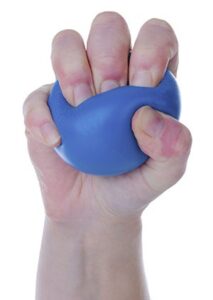 Squeeze the ball and roll it in circles/up and down on the desk. Alternate the ball between hands.
Squeeze the ball and roll it in circles/up and down on the desk. Alternate the ball between hands.
Pushing down on head
Place both hands on top of your head and push down for a maximum of three seconds.
Stretching
Stretch your arms up to the ceiling. This can be achieved in standing or sitting. Hold the stretch for five seconds.
Floor push-ups
Try push-ups on the floor. The knees can be on or off the floor as you do the push up. Complete a maximum of 10 push-ups with breaks, if needed.
Chair press-ups
Place your palms on each side of the chair, then push down while lifting your bottom off of the chair. Hold this position for as long as you can or up to three seconds. Make sure your feet are off the floor, as this means you will put more weight through your arms. Repeat this up to five times.
Strategies to support attention
These sensory regulating activities enable children to regulate their alertness to a ‘just right’ level which, in turn maintains attention and concentration to classroom activities. Those working with the child need to be responsive to how the child is, and use these strategies when they need them.
Movement breaks
 Offer regular movement breaks during the day. Heavy muscle work allows the brain to receive increased feedback on the position of our limbs. The more feedback we can get through heavy muscle work, the more likely we are to have a greater awareness of our body. These activities have a calming effect and help increase attention and concentration.
Offer regular movement breaks during the day. Heavy muscle work allows the brain to receive increased feedback on the position of our limbs. The more feedback we can get through heavy muscle work, the more likely we are to have a greater awareness of our body. These activities have a calming effect and help increase attention and concentration.
Movement seeking
If a child becomes fidgety, offer them a move 'n' sit cushion to regulate their alertness and maintain concentration. This will offer the movement they are seeking.
Oral feedback
Offer crunchy snacks, a water bottle or drink through a straw. The oral movement of crunching on a snack or sucking through a straw or bottle helps to regulate alertness to a ‘just right’ level. This improves attention to task. For example, when doing table top activities, let the child have access to a water bottle.
Theraputty
Theraputty exercises help to develop increased hand and shoulder strength, whilst also improving finger dexterity and pincer grasp. This will positively impact on handwriting, fastening buttons and zips, and pencil grasp. Theraputty also offers increased proprioceptive feedback which acts as a calming activity to support regulation and alertness.
Regulating strategies
If a child communicates that they are either ‘too high’ or ‘too low’, support them to use their strategies keyring to select an activity which will support them to reach a ‘just right’ level of alertness again. Consider a range of activities which target various senses to support them to regulate alertness, for example, oral, tactile, sound and proprioceptive feedback.
Fiddle toys
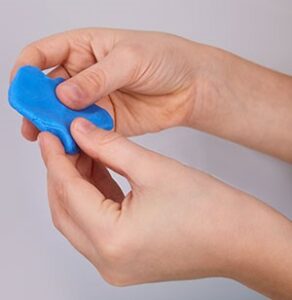 Some children respond positively to tactile feedback. Using a ‘fiddle object’ helps them to maintain prolonged concentration to a task. This can be anything small such as Blu-tack, a paper clip, small piece of theraputty, stress ball or a sensory fiddle toy.
Some children respond positively to tactile feedback. Using a ‘fiddle object’ helps them to maintain prolonged concentration to a task. This can be anything small such as Blu-tack, a paper clip, small piece of theraputty, stress ball or a sensory fiddle toy.
Alertness speedometer
Encourage the child to use their speedometer which prompts them to think about their alertness levels. Learning how to independently recognise their alertness will allow them to think about what they need in order to reach a ‘just right’ level of alertness again. Prompt the child to communicate their alertness at various times of the day and ask them what they need to reach a ‘just right’ level of alertness again.
Brain breaks
These are five quick and simple techniques that can be used in any environment to help the child to focus on tasks and act as calming.
- hold each wrist with the opposite hand and try to pull apart. This gives resistance to the muscles and joints in the arms
- place palms together in prayer position with elbows out to the side. Push palms together and hold for 10 seconds. Repeat up to five times
- sit with hands on side of the seat of the chair and push up so feet lift off the floor and bottom of the chair.
- star jumps 10-15 repeats
- place both hands against a wall and do ‘wall push ups’ (see if their nose can touch the wall). Do this 10-15 times.
Dots and squeezies
Check for painful areas or damaged or sore skin first of all. If found do not continue.
Dots and squeezies is calming and focusing. It is ideal as a warm up and attention getting activity before settling down to do a task. It also helps prepare the hands for writing or other fine finger activity.
- squeeze firmly but not painfully, the top of the left thumb with the fingers and thumb of the right hand. Alternatively, you can squeeze your whole hand around the thumb
- continue with the top, middle and bottom pads of all the other fingers and thumb of the left hand
- squeeze the middle section of the left hand, especially the soft areas
- repeat with the right hand
- cross wrists over and squeeze firmly with both hands just below the opposite wrists
- continue to squeeze, moving hands slowly up each arm until you reach the shoulders
- slowly squeeze back down to your starting point.
Helping with self-care and hygiene
Some children can find learning and developing their self-care skills a challenge, including tasks like teeth brushing and hair washing. These tasks can be difficult due to sensory sensitivities or motor planning challenges. These children need different strategies to build up their skills and confidence in this area.
Helpful strategies
- break down tasks by giving instructions stage-by-stage. Use visuals and photos to help identify a sequence to carry out each task. Laminate these (if possible) and put up in the bathroom to use as part of the morning and bedtime routines
- use equipment to make tasks easier, for example non-slip matting, soap dispensers or a long handled brush
- practice large movements to develop motor planning and kinaesthetic awareness (awareness of the body in space) before trying smaller movements
- give physical prompts, if necessary, for example physically directing hands through a movement
- give definite time limits to the task and acknowledge your child’s feelings.
Tooth brushing
Before brushing try:
- firm massage to mouth
- blowing bubbles or whistle
- deep pressure to mouth by chewing on something strong, pliable, and suitable to put into mouth, such as chewy tubes, can help to calm a highly sensitive mouth before brushing teeth
- place an electric or vibrating toothbrush next to the mouth and teeth
- use a visual timer and checklist.
During brushing
- use warm water
- always brush in front of a mirror so the child can see what they are doing or what you are doing to them
- using a toothpaste pump dispenser may be easier to use than a tube.
- play music – use an app such as Brush DJ
- use less toothpaste
- use flavourless toothpaste or toothpaste that does not foam.
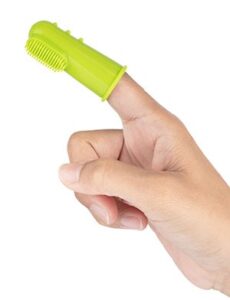 Try different toothbrushes
Try different toothbrushes
- smaller toothbrushes with softer or harder bristles
- three sided toothbrush
- an electric toothbrush
- finger toothbrushes
- chewy toothbrushes that release fluoride as the child chews
- toothbrushes that play music or bleep once two minutes is up
- wisit the websites oranurse.co.uk or boots.com for a selection of the tooth care products
Hair washing
Preparing for hair washing;
- let your child fill the bath themselves and set the temperature, making sure that the boiler is set so the water cannot get too hot. They can add their own bubble bath or none at all if that is what they like
- involve the child in choosing their own bubble bath, shampoo or soap so they can get the product they feel they can use and tolerate
- if your child will tolerate it, use deep pressure to give a head massage before washing. Massage the scalp first before getting it wet or use a vibrating hairbrush.
During hair washing
- warm the shampoo in your hands before putting on your child’s head. It is cold straight from the bottle
- when rinsing the water from your child’s head get them to lean forwards rather than backwards and hold on to the sides of the bath as this is a more stable position
- some children feel physically insecure when they close their eyes to have the shampoo rinsed off. Use a tear free shampoo so they can keep eyes open
- it helps for your child to hold a clean flannel over their eyes too. If they need their face wiped with a towel between each rinse do so. Another alternative is to use goggles or a visor to protect their eyes
- sometimes using a big bowl of water can provide more force and pressure rather than smaller cups. It also takes less time and fewer rinses.
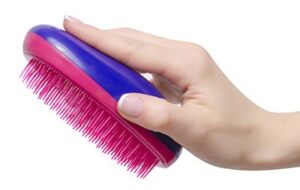 sometimes using a more pressurised spray from the shower head is more comfortable than a weaker spray. Letting your child choose and control the pressure
sometimes using a more pressurised spray from the shower head is more comfortable than a weaker spray. Letting your child choose and control the pressure- using a bath mitt rather than your hands to wash your child’s hair can help. Press down to give deeper pressure
- encourage your child to wash themselves. Self-initiated touch will be easier for your child to cope with
- it can help if you let you child watch or play with the shower head or rinsing vessel for a bit before you wash their hair and rinse it.
- having background music can create a more calming or fun atmosphere
- use ear plugs or waterproof head or ear bands to prevent water getting into the ears
- try no-rinse shampoo and bathing products. These are available at: completecareshop.co.uk/personal-care/no-rinse-shampoo-and-body-wash/ or purpleturtle.co.uk/waterless-shampoo-caps.html as well as many other suppliers (make sure you shop around for the best price)
- if you take a bath with your child, let them pour water over your head and face before doing it to them.
Hair brushing
- prepare the scalp beforehand by pressing down on your child’s head or giving a soothing head massage.
- use a tangle free conditioner
- use a brush with lots of bristles or a specialist detangle comb. This reduces unnecessary tugging at the hair
- let your child see themselves in a mirror while you brush. This will give them a greater sense of control and help them tolerate the brushing more easily
- if your child can brush their own hair, let them. They will have an easier time anticipating and controlling the pain of hitting a knot
- try sitting your child in a beanbag or wrapping them up tight in a rug for deep pressure, while you brush. Some parents have success with weighted vests or weighted lap pads
- always brush from the bottom up. For long hair hold into a ponytail whilst brushing the knotted ends out
- use fun hair accessories or doing hair with friends
- if holding a hair brush is difficult use one with a strap across it, like a pet’s brush
- long handled brushes and combs are available if your child cannot reach behind their head
- sometimes children miss brushing the opposite side of the head because of poor midline crossing. Encourage the child to check whether they have completely brushed their hair in a mirror or remind them to brush the whole of the head
- consider the virtues of a shorter cut until the child becomes less sensitive.
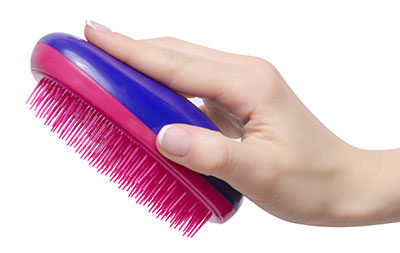
Hair cutting
- prepare the scalp beforehand by pressing down on your child’s head or giving a soothing head massage
- ask the hairdresser to give your child a big, soft brush, a dry washrag with baby powder, or a hairdryer set on cool to blow off stray hairs as it is cut. Use baby powder on irritated skin. Avoid letting the hair fall onto your child’s arms
- use a towel and a clip rather than a Velcro fastening cape. The Velcro may be irritating on the back of the neck
- bring an extra top so your child can change afterwards. Return home straight away for a shower to remove any leftover hairs
- consider having your child’s hair cut at home, away from a salon with unfamiliar smells and sounds
- let your child use a weighted lap pad for calming or play with a toy
- if your child is sensitive to sound, avoid use of a buzz-cut razor. Alternatively you could try to desensitise your child by asking the hairdresser ‘play it’ to them on another occasion – not when they’re due to have a haircut
- try letting your child hold a vibrating toy or electric toothbrush to their hairline, temples and near their ears to desensitise. You could also let them wear earplugs, listen to music or watch something on a device to soothe and distract them.
Oral motor strategies
What are they?
These are strategies that offer enhanced proprioception (our sense of body position in space) and tactile feedback. They also support a child’s motor planning by improving their tongue, lip and jaw and muscle control.
Why are they used?
You can use these strategies if your child frequently mouths or eats non-food items. This suggests they may have low oral motor control.
When are they used?
You can help calm an extra sensitive mouth before meals by chewing on something strong, pliable and suitable to put into the mouth. This provides deep pressure to the mouth which is desensitising.
If you offer regular access to these strategies throughout the day this may reduce your child’s need to lick, bite, chew or eat non-food items. These strategies work by helping to regulate the senses. They improve body awareness and encourage increasing exploration of items with the hands.
Strategies and activities
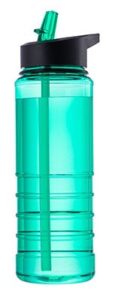 Sucking
Sucking
- use water bottles with sports tops
- drink through a long thin or curly straw
- create ‘fish faces’ with the cheeks and mouth
- suck thick liquids through a straw, such as milkshake, yoghurt, smoothies
- drink fruit puree smoothies through a straw.
Biting, crunching and chewing
- chewy sweets such as gummy bears
- cereal bars
- crunchy foods, fruit, crisps, dry cereal, crackers
- spicy food, such as salsa and curries
- tugging on pieces of liquorice
- crunchy vegetables.
Using chews
- offer something to chew that your child can carry around with them
- there are a variety of chewys on the market, let your child to choose one they like so they are more motivated to use it
- if your child keeps trying to throw these away, consider a reward system. For example, if your child uses their chew for five minutes they can play a favoured game for five minutes during or afterwards
- chewys can be bought from:
Deep pressure
Deep pressure is calming. It causes the release of serotonin and dopamine in the brain. These are happy neurotransmitters and give a feeling of calm within our nervous system.
- offer your child dots and squeezies hand massage
- try a ball squash with a peanut ball or roll your child in a gym mat
- activities involving walking prone over a peanut ball
- offer your child an arm massage using a spiky ball or a shoulder or head massage using your hands.
Toys and games
 These activities will help your child learn how to force air through their mouth and improve control of their lip muscles.
These activities will help your child learn how to force air through their mouth and improve control of their lip muscles.
- use blow pens
- blow bubbles into the air or into a cup of water through a straw.
- pull faces and copy each other.
- play blow football
- blow a whistle, harmonica or other musical wind instrument
- blow up balloons
- use party blowers to knock down Lego towers or hit targets on the wall.
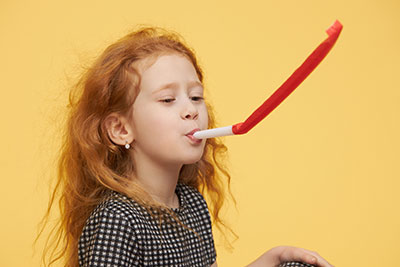
Vibration activities
- encourage your child to use an electric toothbrush or small vibration toy on the outside of their cheeks.
Licking activities
- try licking lips game: Poke the tongue out and go round and round, side to side up and down; try to touch the end of the nose with the tip of the tongue
- lick lollipops, or peanut butter or jam off a spoon
- get child to count their teeth with their tongue
- blow raspberries.
Tactile activities
- encourage messy play activities to increase exploratory play with hands. Try exploring with shaving foam, sand, jelly or water beads
- use play dough or putty. You can make your own play dough and encourage your child to get involved with their hands.
Suggested reading: Ernsperger and Stegen - Hanson. (2004). Just Take a Bite: Easy, Effective Answers to Food Aversions and Eating Challenges.
Calming strategies before bed
Some children need help to regulate their arousal levels before bedtime to enable them to get to sleep. It becomes easier for us to go to sleep if our arousal levels have shifted from high to low before attempting sleep. We can use calming strategies to help to regulate arousal levels just before bedtime. Try incorporating some of the activities listed below into your child’s evening routine.
Heavy muscle work
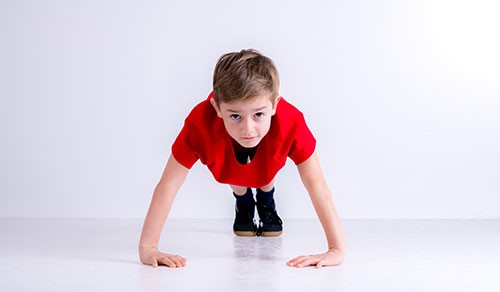
Theory
Heavy muscle work allows the brain to receive increased feedback regarding the position of our limbs. The more feedback we can offer our bodies through heavy muscle work the more likely we are to have a greater understanding of our body awareness in order to attend to both fine and gross motor activities. These kinds of activities can also offer a calming effect.
Strategy
Try out some push/pull activities from our sensory breaks page.
Encourage your child to join in activities, chores and games that involve pushing and pulling and using his muscles, such as using a climbing frame, helping to move furniture, digging, pushing a wheelbarrow or trolley.
Wheelbarrows over a gym or peanut ball
Theory
Using only the upper limbs to support body weight offers the muscles proprioceptive feedback which enhances body awareness. In addition, this position has the potential to improve core and shoulder stability. Heavy muscle work can also act as a calming activity.
Strategy
Encourage your child to lay with his belly on the peanut ball and to support his body weight through outstretched arms. Practice walking hands forward until his feet touch the ball, and then walk back (wheelbarrows). Repeat up to 10 times.
Linear vestibular movement
Theory
The vestibular system is the body’s sensory system responsible for processing movement. Spinning, jumping, running and fast movements are alerting, and slow, rhythmic, forwards and backwards movements such as gentle rocking and swinging have a calming effect on the sensory system.
Strategy
Encourage your child to lay over the top of a gym ball or on a rocker and rock gently forwards and backwards.
Encourage your child to use a swing, swing seat, hammock swing or similar, taking slow steady movements.
Deep pressure
Theory
Deep pressure acts as a calming agent. It causes the release of both serotonin and dopamine in the brain. These are happy neurotransmitters and produce a feeling of calm within our nervous system.
Strategy
Offer your child deep pressure by rolling a peanut or gym ball up and down his body with firm pressure, as long as needed.
Tuck the duvet tightly around your child at night to give him a feeling of containment.
Wrap your child up in a duvet, blanket or yoga mat to give him deep pressure and a feeling of containment.
Offer your child deep pressure by pushing pillows or cushions on his body while lying somewhere soft. Let your child guide the level pressure.
Massage
Theory
Massage and deep pressure offer our bodies increased muscle feedback to our brain, which allows us to understand where our bodies are in space and help us to feel calm and relaxed. For some children deep touch can be comforting, unlike light touch which can sometimes have a negative impact on the senses.
Strategy
Offer your child the dots and squeezies hand massage or encourage them to do this themselves.
Offer your child a deep pressure massage to upper and lower limbs, shoulders and/or head. Be guided by your child as to amount of pressure and location on the body.
Fidget toys

Theory
Some children respond positively to tactile feedback. They enjoy the feeling of certain textures and gain comfort from them. Your child can get this tactile feedback through fidget toys. These are anything small and with a favourable texture, such as Blu-tack, a paper clip, a small piece of theraputty, stress ball, spiral bracelet, spiky ball or feathers.
Strategy
Encourage your child to explore a favoured fidget toy when winding down to go to sleep.
Take a warm bath
Theory
Taking a warm bath before bed can help to relax the muscles in the body and help prepare for sleep. The body receives deep pressure from the weight of the water which increases feedback to the muscles and joints, and the warmth of the water temperature can be calming for many people.
Strategy
Offer your child a warm bath before bedtime.
Lighting

Theory
Visual input has an effect on our arousal states. Bright colours and bright lights are generally alerting, while soft colours and lighting are generally calming.
Strategy
Encourage your child to settle in bed with dim lighting or the lights off with low level sensory lights.
Further resources
Growing hands on kids
A site with ideas videos and information to support a child’s development. Some useful information videos.
OT Plan
Website with activities to support a child’s development. Choose by skill and activity.
Pinterest
Lots of fun sensory activity ideas for home.
Sensory Smarts
Website related to book ‘Raising a Sensory Smart Child’ – free advice and resources on website.
The Inspired Treehouse
Sensory ideas to help children pay attention.
Strategies according to sense
Sight is processed through the ‘Visual’ sense. Visual sensory stimuli is ‘picked up’ through visual receptors located in the eye and are stimulated by light, colour and movement.
ARFID Awareness UK
The UK’s only registered charity dedicated to raising awareness and furthering information about Avoidant/Restrictive Food Intake Disorder. As a not-for-profit, they work to provide individuals, parents, carers and medical professionals with up-to-date relevant information, research and support.
Clothing and resources
- Need a school uniform for autistic child - Spectra Sensory Clothing
- Sleepwear, unitards, sleeping bags | Fledglings
- Sensory bundles – Dignity LC Services
Personal Hygiene For Children With Autism And Sensory Issues - Sensory Direct | weighted blankets, sensory toys and equipment
- SLS free toothpaste | Non foaming | Autism friendly toothpaste (growingsmiles.co.uk)
Non foaming and sodium lauryl sulphate free toothpaste - Your kids table - fussy eaters free workshops - your kid's table
Children's Integrated Therapy Service
Speak to the team for
more information.
Give feedback
Have you used our services and want to give your views?
- Tell us your experience of using our NHS services
- Feedback about our website? Email us kentchft.eastsussexchildrenwebsitefeedback@nhs.net
Kent Community Health NHS Foundation Trust
Local stakeholders
- Contact our Children's Integrated Therapy Service
- Contact our School Health Service
- Support services in East Sussex
